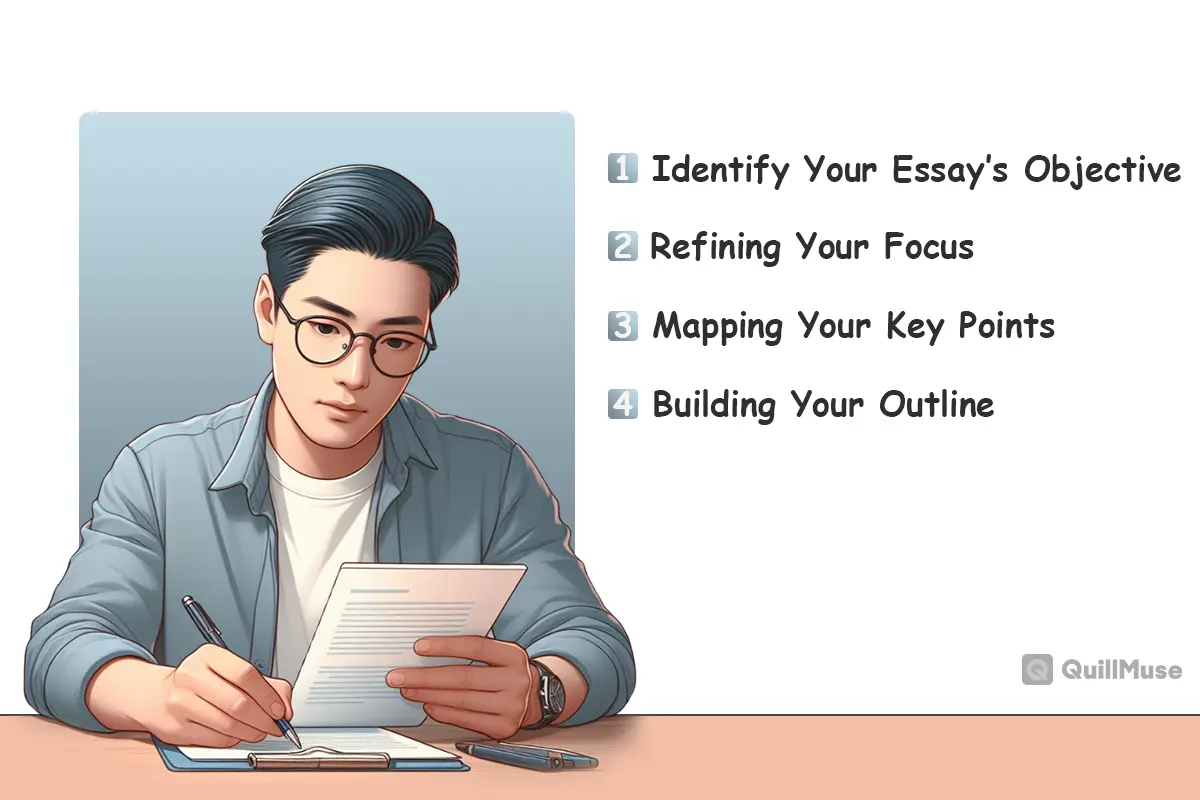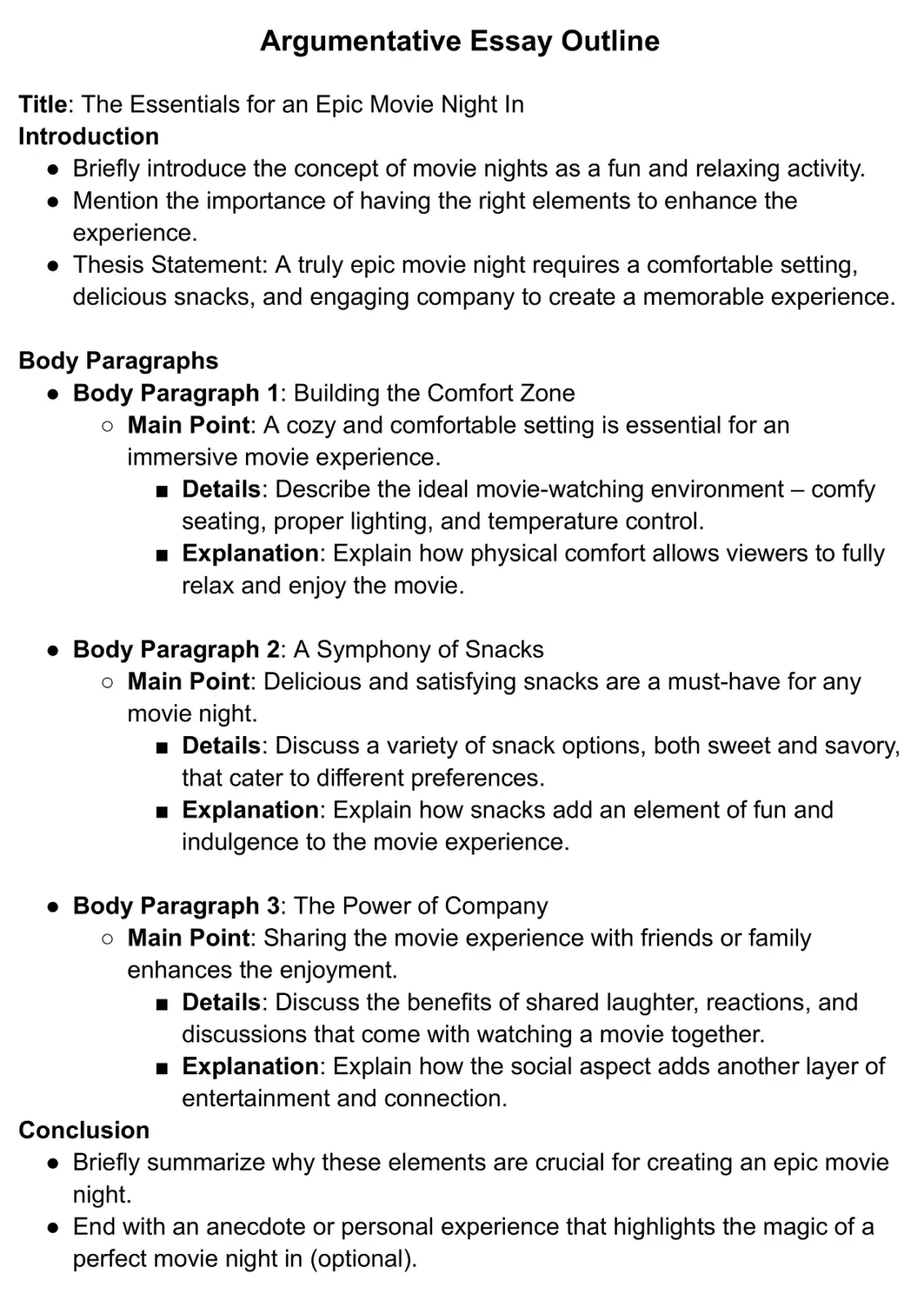How to Write an Essay Outline in 4 Steps | Examples
Learn how to write an essay outline with our expert guide. We also shared some essay outline examples for you to clear understanding. Start writing essays like a pro today!

Rijvi Ahmed
Last updated on Mar 14th, 2024

When you click on affiliate links on QuillMuse.com and make a purchase, you won’t pay a penny more, but we’ll get a small commission—this helps us keep up with publishing valuable content on QuillMuse. Read More.
Table of Contents
Have you ever stared at a blank page, an essay prompt looming, feeling completely lost? You’re not alone. Many students struggle to translate their thoughts into a well-structured and compelling essay. The key to conquering this challenge often lies in a fundamental step: writing a strong essay outline. But you don’t know how to write an essay outline.
This might seem like an extra load, but trust me, it’s an investment that will pay off big time. Consider an outline to be your essay’s template. It offers a clear road map that directs your ideas and arguments systematically and sensibly.
Today, we’ll break down the process of writing an effective essay outline, turning essay writing from a daunting task to a streamlined success story.
Why an Essay Outline is Your Secret Weapon
Writing an essay[1] can feel overwhelming, like staring up a giant mountain. You have a goal in mind or your thesis statement, which is like reaching the peak, but figuring out how to get there feels like a confusing journey. That’s where an essay outline comes in to help you. It’s like a map that helps you:
- Organize your thoughts: Just like packing for a trip, you need to gather your ideas. An outline lets you brainstorm and see how everything connects before you start writing.
- Build a strong argument: A good outline helps you focus on your main points and the evidence that supports them. It’s like planning your route. you know exactly which points you need to hit to reach your destination or thesis.
- Write efficiently: With a clear roadmap, you won’t waste time getting lost. You’ll know exactly what goes in each paragraph, making writing faster and smoother.
- Avoid writer’s block: A blank page can be scary! An outline gives you a starting point and keeps you on track, preventing that dreaded feeling of being stuck.
An outline is basically your personal writing coach, strategist, and cheerleader all in one. It helps you get your thoughts organized, build a strong argument, write faster, and avoid getting stuck. So, next time you have an essay due, forget the fear and grab your outline writing tools. You’ll be surprised at how much easier and more successful writing becomes.
In short, an essay outline is your secret weapon for conquering essay writing. It helps you organize your thoughts, build a strong argument, write efficiently, and avoid writer’s block.
What is a Perfect Essay Outline

You might think an essay outline needs to be super fancy, but that’s not true! The best outlines are clear and organized, and help you build a strong essay. Here’s what goes into this winning formula:
- Clear and Concise: Your outline is like a map, not a story. Use short words or key ideas to show what each part is about. Keep it short and sweet – you can add details later in your essay.
- Logical Flow: Imagine explaining your essay to a friend. Your outline should be like a guide for that conversation. Each part should connect easily to the next, leading your friend (and later, your reader) on a clear and interesting path from the beginning to the end of your essay.
- Thesis Powerhouse: Your thesis statement is the heart of your essay, and your outline should reflect its importance. Make sure your outline clearly highlights your thesis and how each body paragraph supports it.
- Evidence Essentials: Don’t just write down what you’ll talk about in each paragraph. A great outline also mentions the stuff you’ll use to prove your points, like facts, numbers, quotes, or even stories. Having this info handy keeps you on track and helps you write faster.
- Balanced Structure: Think of your essay like a team. Each paragraph is a player, and they all need to work together. Your outline helps make sure each paragraph has its own clear job that supports your main idea.
By following these simple ingredients, you can write an essay outline that serves as a powerful tool for writing success. It will keep your thoughts organized, your arguments focused, and your essay on track for an impressive finish!
The Main Parts of an Essay
Imagine your essay is like a three-act play, with each part working together to tell a clear and interesting story. Here’s a look at the main sections of an essay and what they do:
1. The Introduction
The introduction is like the beginning of a play. It introduces the topic and grabs the reader’s attention. You might start with a question, a surprising fact, or an interesting story to make them want to read more.
Then, you’ll give some background information to help the reader understand what you’re talking about. Finally, you’ll state your thesis statement, which is like the main idea of the play. This is a short sentence that tells the reader exactly what you’ll be arguing throughout your essay.
2. The Body Paragraphs
Think of your essay’s body paragraphs like chapters in a story. Each chapter focuses on one main idea that helps prove your main point or thesis. Imagine you’re trying to convince a friend of something – each chapter would be a reason why they should believe you.
To make your chapters convincing, you need evidence. This is like showing your friend proof! The evidence can be anything from facts and numbers to quotes from experts, or even your own experiences that show your point is true.
Transitions between chapters, like in a story, help things flow smoothly. They connect one idea to the next, making your argument clear and easy to follow. This way, each chapter builds on the one before it, making your overall argument even stronger.
3. The Conclusion
Wrap things up with a strong conclusion, like the final act of a play that leaves the audience thinking. Briefly remind the reader of the key points you made, but avoid just repeating yourself.
Instead, explain why your argument matters and what it means in the bigger picture. End with a thought-provoking idea that ties back to your thesis statement, leaving the reader with something to consider and creating a satisfying finish to your essay.
How to Write an Essay Outline: A 4-Step Guide

Writing a great essay can be tough, but there’s a secret weapon that can make things much easier: the essay outline.
Think of an outline like a map for your essay. It helps you organize your ideas and build a strong argument, just like a blueprint helps an architect build a house. Ready to ditch writer’s block and write your essay with confidence? Let’s break down the steps to creating an awesome outline.
Step 1: Identify Your Essay’s Objective
Every essay has a specific goal, like a top-secret mission! Before you dive into crafting your outline, take a moment to crack the code and understand the type of essay you’re tackling.
Are you a persuasive detective, building a case to convince the reader of your viewpoint, or argumentative essay? Or are you an undercover storyteller, crafting a captivating narrative that unfolds like a thrilling adventure?
It helps you tailor your outline for maximum impact, ensuring you choose the best approach for presenting your ideas and achieving your essay’s goal.
Step 2: Refining Your Focus
Brainstorming is like a fun playground where you can explore all sorts of ideas for your essay. But now it’s time to get serious and focus on your essay’s main goal.
Think of all your brainstorming notes as a giant pile of toys. Now you need to be like Mission Control, picking the toys that will help you launch your essay into outer space (success!).
After considering each concept, ask yourself, “Does this support my main argument?” If you can’t give a clear answer about how the idea supports your main argument, it’s okay to set it aside.
Just keep the important stuff – the ideas that are like powerful rockets, ready to take your essay to the top. Getting rid of the “fluff” helps you focus on the best ideas and build a strong, clear outline.
Step 3: Mapping Your Key Points
Now that you have your mission-critical points, let’s turn them into a winning strategy for your essay. Look at those strong arguments you identified the ones that really back up your main idea.
These will become the main parts of your essay, like chapters in a book, or paragraphs that focus on one key point. Think of it like this: Imagine you’re writing an essay about why your school needs more water fountains.
Your key arguments, the points you want to make, might be:
- Water fountains save students money.
- Fountains help reduce plastic waste.
- Having more water fountains can prevent heat exhaustion.
All these important details you gathered, along with your main points, are like the building blocks of your essay outline. Having a clear outline is like having a roadmap for writing a strong essay. It shows you exactly where to put all your information to create a well-supported and convincing piece of writing.
Step 4: Building Your Outline
Now you’ve figured out your essay goal, sorted through your ideas, and identified your key points. Time to build the actual outline like constructing the skeleton of your essay.
There are different outline styles depending on the essay type. For now, let’s focus on a basic template that works for most essays with an introduction, body paragraphs, and conclusion.
Here’s how to get started:
- Grab Your Template: There are many outline templates available online or in writing guides. Choose one that’s clear and easy to understand.
- Fill in the Blanks: Using the key points and supporting details you identified earlier, start filling out the sections of your outline template.
- Introduction: Briefly mention your topic and hook the reader. Then, state your thesis statement clearly.
- Body Paragraphs: Each paragraph should represent a single key point that supports your thesis. List these points in your outline, along with some brief notes about the evidence you’ll use to back them up.
- Conclusion: Briefly summarize your main points and leave a lasting impression.
Remember, keep your outline clear and concise. Use bullet points, short phrases, or keywords to capture the essence of each section. Don’t get bogged down by writing elaborate sentences at this stage.
By following these steps, you’ll be well on your way to crafting a strong outline that serves as a roadmap to writing success.
Essay Outline Examples
Feeling stumped for an essay topic? No worries! This example shows you how to craft a strong outline for a descriptive essay, focusing on a relatable experience:
Argumentative Essay Outline

Remember, this is just a sample personalize and expand upon this outline to capture the unique elements that make your movie nights truly unforgettable.
Persuasive Essay Outline
Title: Ditch the Car, Ride the Bus: Why Public Transportation Should Be Your Go-To
Introduction
- Briefly introduce the current reliance on personal vehicles for everyday travel.
- Mention the growing concerns about traffic congestion and environmental pollution.
- Thesis Statement: Public transportation offers a more efficient, environmentally friendly, and cost-effective alternative to personal car usage, and its widespread adoption should be encouraged.
Body Paragraphs
Body Paragraph 1: Battling Gridlock
- Main Point: Public transportation significantly reduces traffic congestion on our roads.
- Evidence: Cite statistics on the number of vehicles removed from the road with increased public transport usage.
- Explanation: Explain how fewer cars translate to smoother traffic flow, shorter commute times, and a less stressful driving experience for everyone.
Body Paragraph 2: Saving the Planet, One Ride at a Time
- Main Point: Public transportation plays a crucial role in reducing greenhouse gas emissions and combating climate change.
- Evidence: Cite statistics on the lower carbon footprint of public transport compared to personal vehicles.
- Explanation: Discuss the positive impact of reducing reliance on fossil fuels and creating a cleaner environment for all.
Body Paragraph 3: Saving Money on the Move
- Main Point: Public transportation offers a more budget-friendly option compared to owning and maintaining a car.
- Evidence: Compare the costs of public transportation passes or tickets with the expenses of gas, car maintenance, and insurance.
- Explanation: Highlight how opting for public transport can free up money for other expenses or allow individuals to save for the future.
Conclusion
- Briefly summarize the benefits of public transportation – reduced traffic, environmental protection, and cost savings.
- Emphasize the importance of a shift towards a more sustainable and economical transportation system.
- End with a call to action, encouraging readers to consider using public transportation more frequently (optional).
This example shows you how to take the persuasive essay structure and use it for a new topic. Remember, you can add your own details about public transportation in your area and change them to fit the people you’re writing to!
Admissions Essay Outline
Title: From Shy Singer to Stage Presence: A Band Odyssey
Introduction
- Briefly introduce your initial discomfort with singing and performing in front of others.
- Mention how joining your school band changed your perspective on music and self-expression.
- Thesis Statement: Participating in my high school band transformed me from a shy singer into a confident performer, fostering a deeper appreciation for music and collaboration.
Body Paragraphs
- Body Paragraph 1: Facing the Microphone
- Main Point: Initially, singing and performing in front of others brought on intense shyness and stage fright.
- Details: Describe your feelings of anxiety and how performing felt like a daunting challenge.
- Explanation: Explain how this initial discomfort almost made you quit the band altogether.
- Main Point: Initially, singing and performing in front of others brought on intense shyness and stage fright.
- Body Paragraph 2: The Turning Point: A Supportive Band
- Main Point: The supportive environment and encouragement from your band director and peers played a crucial role in overcoming your shyness.
- Details: Mention specific examples of how your band director or peers helped you feel more comfortable expressing yourself.
- Explanation: Explain how the positive and encouraging atmosphere within the band fostered your confidence and passion for music.
- Main Point: The supportive environment and encouragement from your band director and peers played a crucial role in overcoming your shyness.
- Body Paragraph 3: From Individual Notes to Collective Harmony
- Main Point: Participation in the band emphasized the importance of teamwork and collaboration in creating beautiful music.
- Details: Describe the process of working together with other musicians to achieve a unified sound.
- Explanation: Explain how learning to play your part effectively within the band fostered a sense of teamwork and a deeper appreciation for different musical roles.
- Main Point: Participation in the band emphasized the importance of teamwork and collaboration in creating beautiful music.
Conclusion
- Briefly summarize the transformative impact of band participation on your confidence, self-expression, and teamwork skills.
- Emphasize how these skills developed through music will benefit you in your future endeavors.
Personal Essay Outline
Introduction
- Briefly introduce the special bond you share with your dog.
- Mention a specific incident where your dog’s actions surprised and impressed you.
- Thesis Statement: During a seemingly ordinary walk in the park, my dog, [Dog’s Name], showcased his bravery and became my hero most unexpectedly.
Body Paragraph
- Describe the setting in detail – what park were you in? What was the weather like?
- Explain what happened – what were you doing with your dog when the incident occurred?
- Focus on the details of your dog’s actions – how did they react to the situation? What did they do that surprised you?
Body Paragraph
- Explain the impact of your dog’s actions – did they protect you from danger? Did they alert you to something you missed?
- Describe your emotions after the incident – were you relieved? Grateful? Proud of your dog?
- You can mention specific details or reactions from others that highlight your dog’s heroism.
Conclusion
- Briefly summarize your dog’s heroic act and its significance.
- Reflect on the deepened bond you share with your dog due to this experience.
- You can end with a heartwarming anecdote about your dog’s continued presence as your furry hero (optional).
FAQs: How to Write an Essay Outline
These FAQs will provide some helpful information to readers seeking guidance on how to write an essay outline.
When should I write an essay outline?
There’s no one-size-fits-all answer. Some writers prefer outlining before diving into the first draft, while others use it as they go. Try different things to see what suits you the best.
Isn’t outlining just a waste of time?
On the contrary, an outline saves time in the long run. By organizing your thoughts beforehand, you avoid getting sidetracked and rewriting entire sections later.
What are some common essay outline formats?
There are various formats, but a popular one uses Roman numerals (I, II, III) for main points, capital letters (A, B, C) for sub-points, and Arabic numerals (1, 2, 3) for further details. Bullet points and short phrases are also common for keeping things concise.
Are there any online tools that can help me outline?
Yes! There are several online outlining tools and templates available. They can provide a visual structure and guide you through the outlining process.
Do teachers always require essay outlines?
Not always, but they can be a valuable addition, especially for longer or complex essays. If unsure, always check with your teacher for specific requirements.
How long should my essay outline be?
There’s no set length. It should be detailed enough to guide your writing but not so detailed it becomes a full draft. Aim for clarity and functionality.
How we've reviewed this article
Our content is thoroughly researched and fact-checked using reputable sources. While we aim for precision, we encourage independent verification for complete confidence.
We keep our articles up-to-date regularly to ensure accuracy and relevance as new information becomes available.
- Current Version
- Mar 14th, 2024
- Mar 13th, 2024


